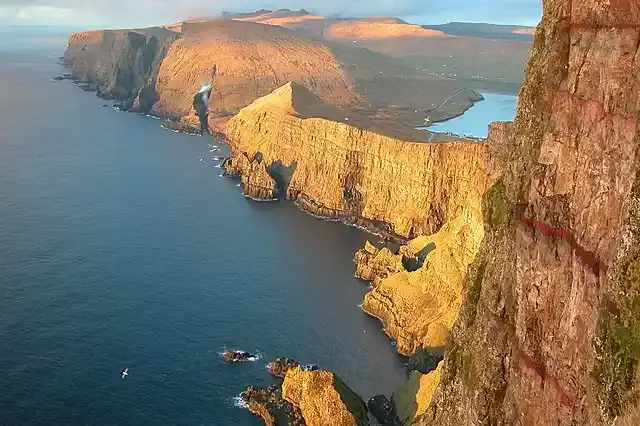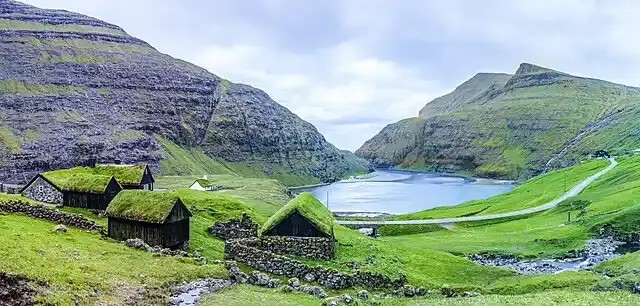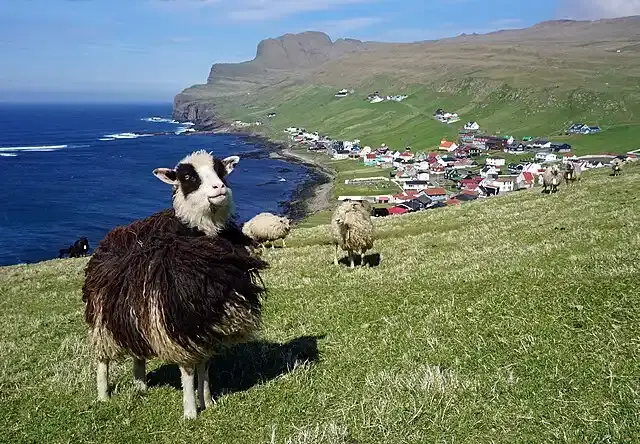Faroe Islands: where ocean meets mountains in a mythical spectacle
Located in the heart of the North Atlantic Ocean, between Iceland and Norway, the Faroe Islands are considered one of the most pristine and natural destinations in the world. Its stunning landscapes, combining towering mountains and green valleys, with the waves of the Atlantic Ocean crashing on rugged beaches, make the Faroe Islands an unforgettable place for adventure and nature lovers. In this article, we will take you on a charming tour to explore the Faroe Islands and why it is a favorite destination for travel and exploration enthusiasts.
Show key points
- The Faroe Islands, located between Iceland and Norway, are renowned for their untouched natural beauty and dramatic landscapes.
- With a history dating back to the Middle Ages, the islands have preserved a rich cultural heritage reflected in their traditions and architecture.
- Outdoor enthusiasts can enjoy a wide range of activities including hiking, kayaking, whale watching, and skiing amid a diverse and rugged terrain.
- ADVERTISEMENT
- Iconic sites like Mount Slataratindur, the village of Gásadalur, and the Múlafossur waterfall highlight the islands' breathtaking scenery.
- The local wildlife, especially seabirds like puffins and marine mammals such as killer whales, draws nature lovers and birdwatchers alike.
- Faroese cuisine is deeply rooted in local ingredients, with traditional dishes like fermented fish and dried lamb offering a taste of island life.
- Travelers are advised to prepare for rapidly changing weather and consider renting a car to easily explore the well-connected islands.
History

The Faroe Islands have a long history stretching back to the Middle Ages, as they were an important stop in the ancient trade routes linking the North Europe with the Atlantic Islands. Although the Faroe Islands are small and isolated, they were home to a strong and close-knit community of farmers and fishermen who relied on the surrounding nature for subsistence. Since then, the islands have preserved their rich cultural heritage, which is evident in traditional buildings and annual celebrations.
Recommend
The picturesque nature of the Faroe Islands
One of the most impressive aspects of the Faroe Islands is its landscape. The islands consist of 18 main islands, all of which feature mountainous terrain and green hills covered with grasses and meadows. Tourists can enjoy the rugged cliffs that dive into the ocean, the tranquil lakes that reflect the surrounding mountains, and the waterfalls that flow from the top of the mountains to the coasts.
Mount Slataratendur
Among the top destinations to visit is Mount Slataratindur, the highest peak in the Faroe Islands. At about 880 meters high, climbing to its top gives you a panoramic view of the ocean and surrounding islands. If you're a hiking enthusiast, this summit offers you a unique challenge and unparalleled visual reward upon arrival.
Gasadalor Village and Molavosur Waterfall

No visit to the Faroe Islands is complete without heading to the village of Gasadalore, famous for its magnificent scenery that seems to have come out of a fictional book. Surrounded by mountains on three sides and overlooking the ocean on the fourth, this small village is ideal for those looking to relax in a tranquil setting. Near the village is the Molavosaur Waterfall, one of the most famous waterfalls in the Faroe Islands, where its waters fall from the top of the cliff directly into the ocean in a breathtaking scene.
Wildlife and biodiversity
In addition to the magnificent landscape, the Faroe Islands are famous for their rich wildlife, especially seabirds. The archipelago is a safe haven for large numbers of birds, such as puffins and guilmots, who breed on the islands' cliffs. For birdwatchers, visiting the Faroe Islands is an unmissable opportunity to see these rare birds in their natural habitat.
The nutrients-rich waters of the Faroe Islands also attract different species of fish and whales, making whale watching trips one of the fun activities you can enjoy during your visit. Killer whales and dolphins can be seen showing off their ability in the waters around the islands.
Faroese culture and traditions
Besides the amazing nature, the Faroe Islands embraces a unique culture and tradition. Islanders are closely connected to the sea and land, with fishing and farming forming an essential part of their lifestyle. Despite geographical isolation, Faroese residents are keen to preserve Faroese traditions that are passed down from generation to generation, whether through traditional food or arts and music.
Farroy food

Farawi cuisine reflects the nature of the surrounding environment, relying mainly on local products such as fish and lamb. Some of the most popular Faroe dishes to try are Skirpesque, which is prepared from traditionally dried and salted meat, and ravik, a fermented fish that is part of Faroe Islands' food heritage. Visitors can enjoy tasting these traditional dishes at local restaurants, which offer an authentic dining experience.
Adventures & Outdoor Activities
The Faroe Islands are an ideal destination for lovers of outdoor activities and adventures. Thanks to its diverse terrain, visitors can enjoy a wide range of sports activities such as windsurfing, kayaking, mountain skiing, and hiking. Changing weather conditions and volatile landscapes add a touch of excitement to these activities, making each adventure a unique and unrepeatable experience.
Kayaking
Adventurers who prefer to explore the water can enjoy kayaking tours around the islands, where they can view sea caves and towering cliffs from a new angle. Visitors can also try kayaking between islands to navigate and explore remote areas that cannot be reached by road.
Trekking on foot
The Faroe Islands are also a hiking paradise, with a variety of trails to suit all levels. Visitors can enjoy walking through green meadows, or climb to the mountain peaks to enjoy stunning views of the Atlantic Ocean. There are popular trails such as the Calfsbachen Trail which runs through some of the islands' most beautiful landscapes.
Travel to Faroe Islands: practical tips

If you are planning to visit the Faroe Islands, it is important to be aware of some practical things to ensure a comfortable and enjoyable experience.
Climate
The Faroe Islands have a temperate oceanic climate, which means the weather can change quickly. In one day you may encounter sun, rain, and fog, so it's a good idea to be prepared for all weather conditions. It is recommended to wear waterproof clothing and take care of multiple layers of clothing to adjust them as needed.
Navigation
The car is the best choice for moving between islands, as there is an excellent system of tunnels and bridges that connect most of the major islands. Visitors can also use ferries to navigate between smaller islands. It is advisable to rent a car to enjoy complete freedom in exploring the islands and enjoying the picturesque landscapes.
Accommodation
There is a wide range of accommodation options in the Faroe Islands, from luxury hotels to simple cottages. It is preferable to book accommodation in advance during the summer, as this is the busiest time due to the influx of tourists to enjoy the mild weather.
One of the most beautiful and unique natural destinations in the world, Faroe Islands is an ideal destination for nature and adventure lovers. Thanks to its picturesque landscapes and biodiversity, the Faroe Islands offer an unforgettable tourist experience. Whether you want to relax amidst tranquil mountains, or enjoy challenging adventures in nature, the Faroe Islands offers everything that travel lovers could dream of.








